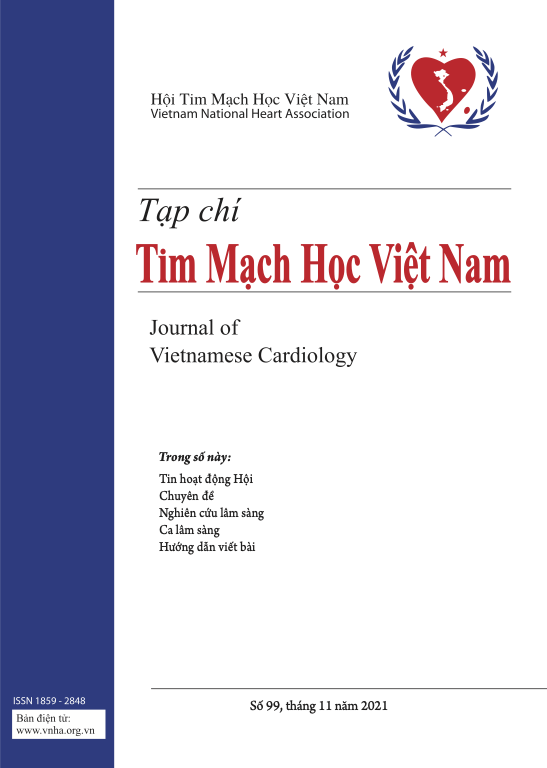Wellens syndrome: A warning sign of an impending "catastrophe"
DOI:
https://doi.org/10.58354/jvc.112E.2024.462Từ khóa:
Acute coronary syndrome, Wellens syndrome, Pseudo-normalized T-waves, EchocardiogramTóm tắt
The term acute coronary syndrome includes a set of symptoms and signs attributable to acute myocardial ischemia that is generally due to the rupture or erosion of an atherosclerotic plaque with the consequent formation of a thrombus that totally or partially obstructs the involved coronary artery. It has a wide range of clinical presentations. The electrocardiogram plays an important role in the diagnosis and treatment of acute coronary syndrome, the spectrum includes a normal electrocardiogram, T-wave abnormalities, ST-segment depression, or ST-segment elevation. It is also useful for acute coronary syndrome presentations that are not so typical and can sometimes go unnoticed, such as right or left bundle branch block, posterior wall myocardial infarction, de Winter T wave pattern, and Wellens syndrome. A case of Wellens syndrome was identified in an outpatient cardiology consultation, the patient was immediately referred for urgent invasive coronary angiography, and as a result, a stent was successfully implanted from the ostium of the anterior descending coronary artery. The early identification of these variants is valuable so that the patient receives optimal drug treatment and is referred on time to invasive coronary angiography. The role of the echocardiogram with strain imaging and its contribution to the diagnosis is highlighted.
Tài liệu tham khảo
de Zwaan C, Bär FW, Wellens HJ. Characteristic electrocardiographic pattern indicating a critical stenosis high in left anterior descending coronary artery in patients admitted because of impending myocardial infarction. Am Heart J. 1982;103(4 Pt 2):730-736. doi:10.1016/0002-8703(82)90480-x
![]()
de Zwaan C, Bär FW, Janssen JH, et al. Angiographic and clinical characteristics of patients with unstable angina showing an ECG pattern indicating critical narrowing of the proximal LAD coronary artery. Am Heart J. 1989;117(3):657-665. doi:10.1016/0002-8703(89)90742-4
![]()
Tang N, Li YH, Kang L, et al. Entire process of electrocardiogram recording of Wellens syndrome: A case report. World J Clin Cases. 2022;10(19):6672-6678. doi:10.12998/wjcc.v10.i19.6672
![]()
Wang X, Sun J, Feng Z, et al. Two case reports of Wellens' syndrome. J Int Med Res. 2018;46(11):4845-4851. doi:10.1177/0300060518800857
![]()
Bergmann I, Büttner B, Teut E, et al. Pre-hospital transthoracic echocardiography for early identification of non-ST-elevation myocardial infarction in patients with acute coronary syndrome. Crit Care. 2018;22(1):29. doi:10.1186/s13054-017-1929-1
![]()
Karlsen S, Dahlslett T, Grenne B, et al. Global longitudinal strain is a more reproducible measure of left ventricular function than ejection fraction regardless of echocardiographic training. Cardiovasc Ultrasound. 2019;17(1):18. doi:10.1186/s12947-019-0168-9
![]()
Lin AN, Lin S, Gokhroo R, et al. Cocaine-induced pseudo-Wellens' syndrome: a Wellens' phenocopy. BMJ Case Rep. 2017;2017:bcr2017222835. doi:10.1136/bcr-2017-222835
![]()
Inayat F, Riaz I, Ali NS, et al. Pseudo-Wellens' syndrome secondary to concurrent cannabis and phencyclidine intoxication. BMJ Case Rep. 2018;2018:bcr2018225755. doi:10.1136/bcr-2018-225755
![]()
Ju TR, Yeo I, Pontone G, et al. Pseudo-Wellens syndrome from sepsis-induced cardiomyopathy: a case report and review of the literature. J Med Case Rep. 2021;15(1):151. doi:10.1186/s13256-021-02756-y
![]()
Win Htut Oo SZ, Khalighi K, Kodali A, et al. Omnious T-wave inversions: Wellens' syndrome revisited. J Community Hosp Intern Med Perspect. 2016;6(4):32011. doi:10.3402/jchimp.v6.32011
![]()
Rhinehardt J, Brady WJ, Perron AD, et al. Electrocardiographic manifestations of Wellens' syndrome. Am J Emerg Med. 2002;20(7):638-643. doi:10.1053/ajem.2002.34800
![]()
Tandy TK, Bottomy DP, Lewis JG. Wellens' syndrome. Ann Emerg Med. 1999;33(3):347-351. doi:10.1016/s0196-0644(99)70373-2
![]()
Zhou L, Gong X, Dong T, et al. Wellens' syndrome: incidence, characteristics, and long-term clinical outcomes. BMC Cardiovasc Disord. 2022;22(1):176. doi:10.1186/s12872-022-02560-6
![]()
Kylmälä MM, Antila M, Kivistö SM, et al. Can strain rate imaging predict recovery of contraction after acute myocardial infarction?. Eur J Echocardiogr. 2011;12(5):364-371. doi:10.1093/ejechocard/jer026
![]()
Martínez P, Thanh DB, Pérez RT, et al. El ecocardiograma en el diagnóstico de la disfunción miocárdica por sepsis. Revista Cubana de Cardiología y Cirugía Cardiovascular. 2022;28(3).
![]()
Mghaieth Zghal F, Boudiche S, Haboubi S, et al. Diagnostic accuracy of strain imaging in predicting myocardial viability after an ST-elevation myocardial infarction. Medicine (Baltimore). 2020;99(19):e19528. doi:10.1097/MD.0000000000019528
![]()








